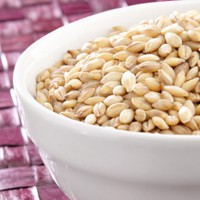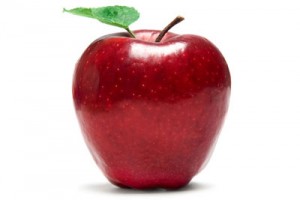on Aug 6, 2014 in Nutrition, Weight Loss, Wellness Blog
Cooking With Barley Traditionally American diet’s are rich in wheat. But the wheat grown now is genetically different from the wheat our grandparents ate because it has been genetically modified over the last two decades. These newer strains of wheat are not as widely tolerated and have increased the incidence of wheat allergies and gluten-intolerance. It is estimated that as high as 40% of the population has some reaction to wheat, which leaves many of us looking for alternative healthy grain sources. One great alternative is Barley, a staple of soups and stews. Barley is the oldest known domesticated grain, grown for 10,000 years as food for humans and animals, and as the basis of the first alcoholic beverages. Like millet, barley comes in hulled and pearled varieties; hulled barley is the true whole-grain form, with only the outermost hull removed, whereas pearled barley is polished to remove the bran layer and often the inner endosperm layer as well.Pearled barley is both easier to find and the type called for in most recipes. To use hulled barley (which you can find in health food stores) in place of the pearled variety in any recipe, increase the cooking time. Barley is an excellent source of fiber (one cup cooked containing 13 grams); its insoluble fiber helps maintain large populations of friendly bacteria in the digestive tract. Additionally, barley has been shown to aid in regulating blood sugar after meals (more so than other grains of similar glycemic index, like wheat) for up to 10 hours, most likely thanks to the colonic fermentation of barley’s indigestible carbohydrates. This finding is good news for diabetics and others concerned with their blood glucose levels. Like wheat and rye, barley is a gluten grain and is therefore unsuitable for those with celiac disease or gluten intolerance. Cooking time: pearled, 45-60 minutes; hulled, 90 minutes Liquid per cup of grain: 3 cups How to cook barley: Combine barley and water in a pot and bring to a boil. Reduce heat, cover and simmer until...
Read More
on Jul 30, 2014 in Fitness, Nutrition, Weight Loss, Wellness Blog
Read More
on Jul 15, 2014 in Nutrition, Weight Loss, Wellness Blog
According to a study published in the England Journal of Medicine, potato chips were the most “weight inducing food tested”. The coating of salt, fat, and sugar found on and in the starch of the potato provide the brain with a powerful appetite inducing single, causing you to want more. The starch in potato chips absorbs more quickly than even sugar causing large spikes in blood glucose and insulin, which promotes weight gain. In sharp contrast to potato chips, eating an unprocessed baked potato with the skin has been shown to curb appetite. Lesson… avoid processed foods and re-learn the joys of foods in their natural...
Read More
on May 12, 2014 in Fitness, Healthy Skin, Nutrition, Wellness Blog
Exercise not only appears to keep skin younger, it may also even reverse skin aging in people who start exercising late in life, according to surprising new research. After about age 40, most of us begin to experience a thickening of our outer layer of skin. This layer of skin gets drier, flakier and denser with age. At the same time, the layer of skin beneath begins to thin and loses elasticity, giving the skin a more translucent and often saggier appearance. These changes are solely the result of the passage of time. Recently, researchers at McMaster University in Ontario began to wonder if this aging was inevitable. Researchers set a group of sedentary volunteers to exercising, after first obtaining skin samples from their buttocks. The volunteers were aged at 65 or older and, at the study’s start, had normal skin for their age. They began a fairly straightforward endurance training program, working out twice a week by jogging or cycling at a moderately strenuous pace, equivalent to at least 65 percent of their maximum aerobic capacity for 30 minutes. This continued for three months. At the end of the study time, the researchers again biopsied the volunteers’ skin and the skin of the study volunteers no longer correlated with their true age, but the outer and inner layers that looked very similar to those of 20- to 40-year-olds. “It was pretty remarkable to see,” said Dr. Tarnopolsky, himself a middle-aged exerciser. Under a microscope, the volunteers’ skin “looked like that of a much younger person, and all that they had done differently was...
Read More
on May 1, 2014 in Nutrition, Uncategorized
2014 Shopper’s Guide to Pesticides in Produce Two-thirds of produce samples in recent government tests had pesticide residues. Don’t want to eat bug- and weed-killers? Check out EWG’s Shopper’s Guide to Pesticides in Produce . It is worth your health to purchase organic when possible, particularly for children and teens. The following list is the fruits and vegetables that test the highest for pesticide residues. If you see a food you regularly eat on this list, choose the organic version instead. Remember – the health benefits of a diet rich in fruits and vegetables outweigh risks of pesticide exposure. Dirty Dozen Plus™ APPLES , STRAWBERRIES, GRAPES, CELERY, PEACHES, SPINACH, SWEET BELL PEPPERS, NECTARINES – IMPORTED, CUCUMBERS, CHERRY TOMATOES, SNAP PEAS – IMPORTED, POTATOES, HOT PEPPERS, KALE/COLLARD GREENS, AVOCADOS, SWEET CORN, PINEAPPLES, CABBAGE, SWEET PEAS-FROZEN, ONIONS, ASPARAGUS, MANGOES, PAPAYAS, KIWI, EGGPLANT, GRAPEFRUIT, CANTALOUPE, CAULIFLOWER, SWEET...
Read More
on Feb 24, 2014 in Nutrition, Weight Loss, Wellness Blog
Get the pdf version of this article Your WEIGHT: It’s About More than Just a Number. If you struggle with excess weight you needn’t feel alone. Seventy percent of Americans struggle right along with you, with thirty-six percent of them carrying more than 35 pounds of extra weight. Unquestionably, obesity has become epidemic in the United States. A fact that is particularly alarming when you consider that extra pounds have been linked to heart disease, diabetes, cancer, Alzheimer’s, kidney disease, arthritis, asthma, auto-immune disease, and early death. But does obesity itself mean you’re unhealthy? While two-thirds of overweight people do develop weight-related health problems, one-third do not, and they don’t appear to be at an increased risk for health problems either. One cannot help but ask; what is different about the one-third of overweight people that keeps them healthy? While time and research will provide more clues, what we do know is the answer has a lot to do with diet and, most importantly, the health of their body fat. Traditionally, fat cells have been viewed as metabolically inactive storage units for extra calories. But newer research reveals that fat cells are much more complex and actually metabolically very active. While the full scope of the effects of body fat on health are just now beginning to be understood it is apparent that body fat acts like a major organ similar in importance to the heart, kidney, or liver. Fat cells produce hormones that control a host of body functions, particularly appetite, metabolism, and body weight. What determines a person’s health may have less to do with the number on the scale, and more about how well their body fat functions. Healthy fat cells regulate body weight by secreting several hormones. One, called adiponectin, is released when calories from food enter the blood stream. Adiponectin speeds up metabolic rate, helping burn off calories. Fat cells also release grenalin and leptin which work together to decrease hunger and increase fullness. Fat cell health appears to be dependent on the quality of our diet, and in particular on the type of fats we eat to maintain function. Most likely what determines whether overweight people are healthy or unhealthy is the quality...
Read More




